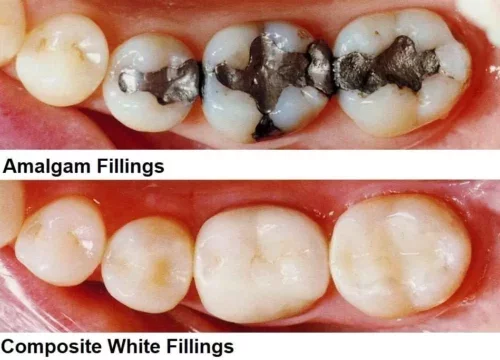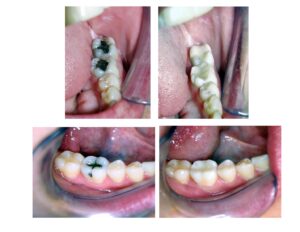
What is a dental filling?
Dental fillings are a safe material that are used to ‘fill’ areas of a tooth where decay had been recently removed. Dental fillings are also used to repair cracked and broken teeth and even teeth that may have been worn down from misuse.
What type of materials are used in a dental filling?
Patients at Valley of the Sun Dentistry can get their teeth filled with cast gold, silver (amalgam), composite resin, ceramic, and glass ionomer. Circumstances such as the location and extent of the decay, cost of the filling material, insurance coverage, and personal preferences may affect which type of filling is best for you.
Every dental filling material has advantages and disadvantages. Dr. Fink will discuss these advantages and disadvantages with you along with your circumstances to help determine which dental filling material would be best for your oral health.
(Cast) Gold
Advantages:
Gold fillings are durable, lasting anywhere from 10 to 15 years or more, and they don’t corrode. They are also strong, they can withstand typical chewing forces. Lastly, gold fillings are more aesthetic than typical silver amalgam fillings.
Disadvantages
Gold fillings are expensive, typically costing up to 10 times more than silver amalgam fillings. They also require an additionally office visit to place in your teeth. Additionally, if you have a gold filling placed right next to a silver amalgam filling, it may cause a sharp pain (galvanic shock). This is caused by the interaction between the different metals and saliva, which can rarely generate an electric current. Finally, gold fillings, while may seem appealing to some patients, most patients dislike metal “colored” fillings, and prefer natural colored fillings.
Silver (Amalgam)
Advantages:
Silver fillings are durable, and usually last between 10 to 15 years, even outlasting composite (tooth colored) fillings. Silver is also strong enough to withstand typical chewing forces. Finally, silver fillings are less expensive than composite fillings.
Disadvantages
Silver fillings don’t match the natural color of teeth. This is most evident when you consider that the fillings typically create a grayish hue in the surrounding tooth. In order for silver fillings to be set, a larger, healthy section of the tooth needs to be removed in order to keep the filling in place. Silver fillings are most susceptible to expansion and contraction in the presence of hot and cold liquids. This results in a higher incidence of cracks and fractures in the tooth. Finally, about 1% of people are allergic to mercury, which is a part of the amalgam filling.
Composite Resin
Advantages:
Aesthetically speaking, composite resin fillings are the best option for matching the natural color of your teeth. This makes it the best option for fillings in front teeth or other more visible teeth. Additionally, composite resin fillings are able to micro-mechanically bond to your natural tooth structure, providing better support for the filling. This makes composite resin particularly useful for repairing chipped, broken, or worn teeth. This also means that less material needs to be removed from your tooth in order to set the filling.
Disadvantages:
One of the biggest flaws of composite fillings is that they tend to wear out sooner than amalgam fillings. Composite resin fillings last for a minimum of 5 years. Additionally, they can wear out sooner since they aren’t as capable of withstanding chewing forces and can chip away, depending on the location, especially if they are used for larger cavities. They also require more time to apply properly to your teeth, taking up to 20 minutes longer than amalgam fillings. Additionally, if composites are being used on inlays or onlays, they may need another office visit to apply. Finally, composite fillings can cost up to 2 times as much as amalgam fillings.
Ceramic
Advantages:
Ceramic fillings can be colored to look similar to the color and feel of your existing teeth. They are also more resistant to stains than composite resin fillings. Finally, ceramic fillings, with the proper care, can last up to 20 years.
Disadvantages:
Ceramic fillings are more expensive than other fillings, often costing more than gold fillings. Typically, ceramic fillings require 2 dental visits in order to completely set them. Finally, if you are getting an inlay or an onlay, your tooth will need to be reduced in size in order to make room for and allow the ceramic filling to bond completely to the remaining tooth.

Do older fillings need to be replaced?
Fillings should not be redone unless they are either bothersome, have new decay, show signs that the teeth are cracking, or some other problem is developing that will benefit from a new filling or a crown.
But, one thing that bothers people about their old dental fillings is the color. In the past, most fillings were done in silver. It is still used, but not as much as a few years ago. Silver fillings look like a black spot on the surface of a tooth. And, it usually makes the entire tooth look a little gray because the silver shows through the sides of the translucent enamel. If the black look of a silver amalgam dental filling is bothersome to a patient, it can be replaced with a white restoration and appear more like a natural tooth.The pictures below are samples of what we have done at Valley of the Sun Dentistry

